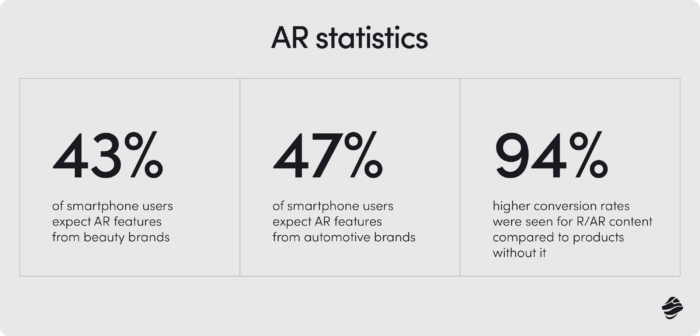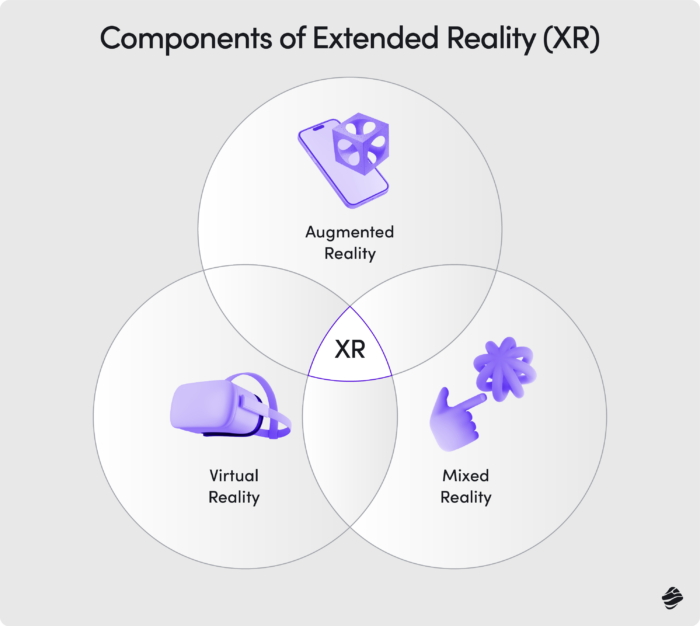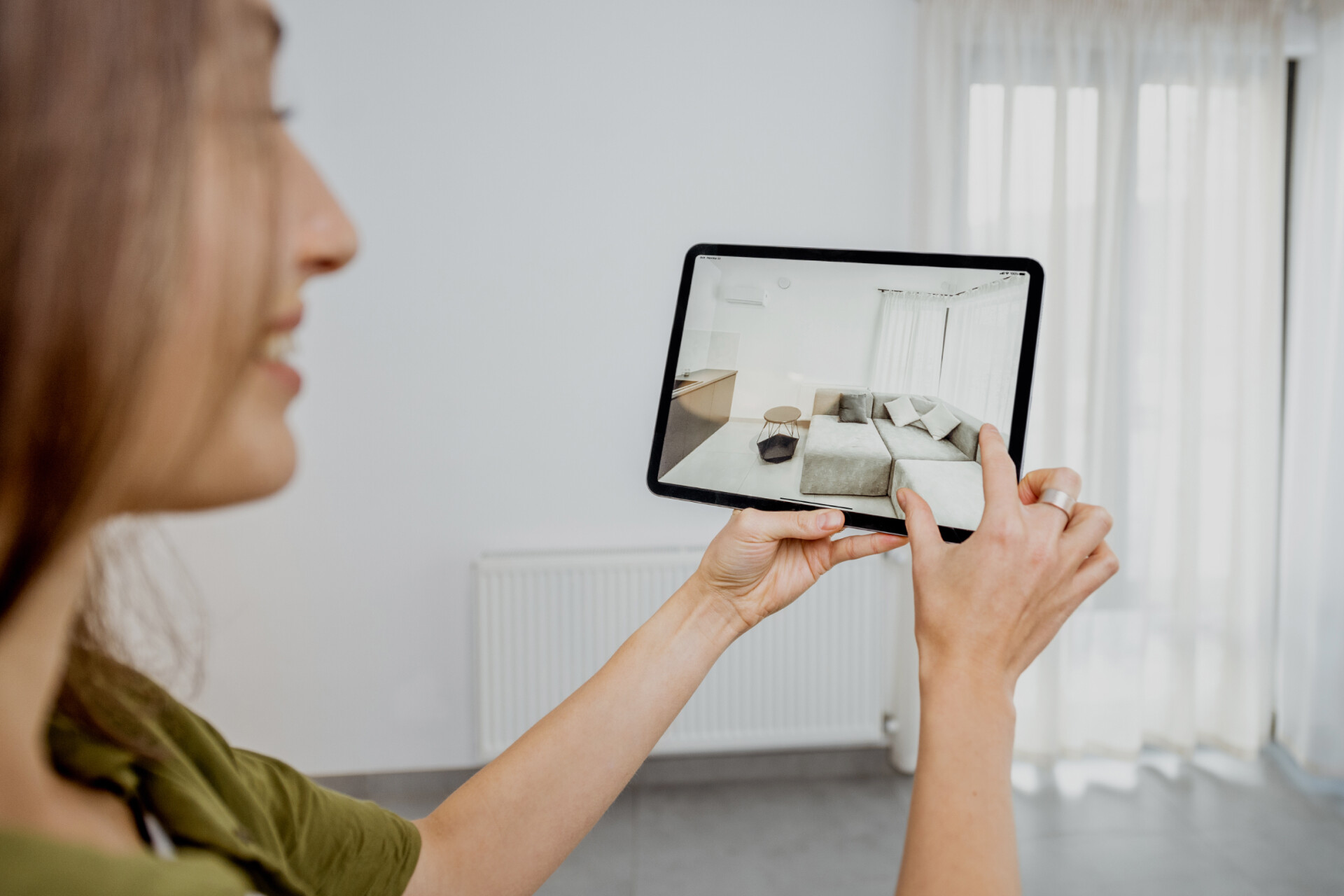Initially associated primarily with entertainment, AR solutions have now become an integral part of numerous industries. In eCommerce, AR is already well-established, proving to be an excellent way to boost sales. Following in the footsteps of IKEA and leading beauty brands, more and more companies are choosing to integrate these features and AR apps into their offerings. AI is also increasingly transforming businesses by enabling AI development services. Today, we’ll take a closer look at AR, analyzing how to harness its potential in eCommerce.
What is augmented reality in eCommerce?
Augmented Reality (AR) in e-commerce is a cutting-edge technology that transforms the online shopping experience by overlaying digital elements onto the real world. By utilizing a device’s camera, display, and sensors, AR technology creates a seamless blend of physical and digital environments. This immersive experience allows online shoppers to interact with products in a more detailed and realistic manner.
For instance, customers can visualize how a piece of furniture would look in their living room or try on virtual makeup to see how different shades suit their complexion. This enhanced interaction not only makes online shopping more engaging but also helps customers make more informed purchasing decisions.
Brief history and evolution of AR in eCommerce
The journey of Augmented Reality technology began several decades ago, primarily within the realms of gaming and entertainment. However, its potential in e-commerce started to unfold with the advancement of mobile devices and the increasing popularity of online shopping.
In the early 2000s, AR was a novel concept, but it wasn’t until 2017 that it made a significant impact on e-commerce. IKEA’s launch of the IKEA Place app marked a pivotal moment, allowing customers to virtually place furniture in their homes using AR. This innovation set the stage for other eCommerce businesses to explore and adopt AR technology. Today, AR has become a vital tool for enhancing the online shopping experience, offering customers a more interactive and personalized way to shop.
AR in the eCommerce Industry: what pushed its rise?
The growing share of mobile devices in eCommerce sales has significantly contributed to the adoption of AR solutions. Mobile integration allows users to experience AR features in real-time, which is a real advantage for industries like interior design and beauty. All it takes is granting camera permissions on a smartphone, and AR features become accessible.
The rise of AR is also closely linked to the post-pandemic growth of eCommerce. The risk of buying the wrong product and having to return it can be a major barrier for some customers. AR helps eliminate part of that risk by offering a more immersive shopping experience. It’s no wonder that in recent years, many companies have invested in such enhancements.
Benefits of AR for online retailers
At first glance, AR features might seem like the “cherry on top” for retailers, primarily aimed at creating a wow factor. In reality, they bring several tangible benefits.
Customer engagement
AR is still not a commonplace integration, which naturally sparks curiosity. Customers may download an eCommerce app simply to try out the new feature. AR apps can spark curiosity and drive customer engagement by allowing users to visualize products in their actual surroundings and interact with them in 3D. This curiosity provides a great sales opportunity—if the feature is well-designed and paired with properly targeted integrations, you have a winning chance of converting those curious customers into buyers.
A satisfied customer is an engaged customer—ultimately, augmented reality also adds an element of entertainment. Users can visualize hypothetical decor scenarios or virtually try on clothes they might hesitate to pick up in a physical store because they do not fit their typical style. Customers are intrigued, download the app, use the features, and engagement statistics increase. Even for large brands, app store rankings are crucial, and AR helps drive downloads.
Increased conversion rates
AR gives customers a taste of the offline experience in the online world, addressing one of the key barriers in eCommerce—the inability to try products before buying. Augmented reality further enhances the experience by adding possibilities unavailable in physical stores. Customers can “try on” products, view them in 3D from any angle, visualize dimensions and shapes more accurately, and check how items would fit in their available space. This combination can be a powerful push forward for increasing store conversions.
Reduced returns
Returns are problematic for both customers and stores. Of course, eCommerce platforms compete to simplify the returns process and make it hassle-free—this greatly influences customer satisfaction. However, returns still incur additional costs, including transportation, processing returned products, managing inventory, and repackaging.
Moreover, let’s not forget the waste generated during the returns process, such as cardboard boxes and packing materials. With upcoming ESG regulations, these processes will only become more costly. Investing in AR simply makes financial sense for eCommerce companies, especially in furniture and interior design sectors, where logistics are more complex and require non-standard, larger packaging.

Types of augmented reality experiences
Marker-based AR for product recognition
Marker-based AR is a fascinating type of augmented reality experience that relies on physical markers, such as QR codes or logos, to trigger digital interactions. When a customer scans these markers using their mobile device, the AR experience comes to life, providing an immersive and interactive way to engage with products. In the e-commerce industry, marker-based AR is particularly useful for product recognition.
For example, a customer can scan QR code on a product’s packaging to instantly access detailed information or customer reviews. This not only enhances customer engagement but also helps e-commerce businesses provide a richer, more informative shopping experience. By integrating marker-based AR, online retailers can bridge the gap between physical and digital shopping, making the process more seamless and enjoyable for online shoppers.
Technical challenges in implementing augmented reality in eCommerce businesses
Implementing augmented reality in e-commerce presents several significant technical challenges. Check which technical aspects you will need to resolve in order to unlock the full AR’s potential.
Permissions for camera access
Augmented reality experiences on mobile devices require users to grant permission to access their cameras. While this is essential for the technology to function, it can deter users due to privacy concerns. Additionally, getting these permissions across different operating systems and ensuring a smooth experience adds to the complexity.
Cybersecurity risks
Allowing camera access comes with inherent cybersecurity risks. Users need to trust that their privacy is not being compromised. E-commerce platforms must ensure robust security measures to mitigate these risks, which often involves compliance with strict data privacy regulations.
Creating accurate 3D models
AR-based e-commerce requires highly detailed and accurate 3D models of products. Developing these models can be both time-consuming and resource-intensive, as they need to closely match the physical items to provide a realistic virtual experience.
Interactive interfaces
Developing interactive and intuitive interfaces is crucial for augmented reality adoption in e-commerce. However, creating these interfaces presents challenges, particularly in balancing design complexity and performance. The goal is to create an engaging, seamless experience without compromising the application’s speed or responsiveness, which requires significant design expertise and testing.
Financial challenges in implementing AR
Beyond technical hurdles, the financial aspects of implementing AR in e-commerce also pose substantial challenges. Whether carrying out the project on your own or collaborating with an eCommerce development services provider, you should consider these obstacles in your strategy. To get a better understanding of potential expenses, check our AI App Development Costs Guide for a detailed breakdown of factors affecting the cost of AI and AR integration.
High implementation costs
AR is not a cheap technology to implement. It involves multiple layers, including developing augmented reality software, creating 3D content, and ensuring cross-device compatibility. The cost of these elements adds up, making it a considerable investment, particularly for smaller e-commerce businesses.
Involvement of specialists
The complexity of augmented reality means it requires the engagement of various specialists, such as 3D artists, UI/UX designers, AR developers, and cybersecurity experts. This need for diverse expertise not only increases implementation costs but also adds to the challenge of recruiting the right talent, which can be a time-consuming process
Augmented reality and mobile shopping
In a 2019 Think with Google research, 2 in 3 people clamied they are interested in harnessing AR to help them when shopping. While consumers have always been intrigued by AR features, the rise of mobile commerce has opened the door to wider adoption. The mobile camera has become a powerful tool that, when paired with appropriate software and often 3D modeling, enhances consumer research.
Mobile devices and augmented reality are closely intertwined. On one hand, mobile devices provide access to built-in sensors that other devices lack. On the other, within a mobile app, creating a consistent and seamless AR experience is much easier compared to a browser or web app.
Mobile apps have direct access to device hardware and sensors, enabling more efficient and stable AR functionalities. In contrast, browser-based augmented reality relies on web standards and APIs that can present limitations or inconsistencies across different browsers, potentially affecting performance.
Augmented reality in eCommerce: case studies
IKEA AR app
IKEA has continued to innovate in enhancing customer experiences through technology. A key aspect of their strategy has been the integration of augmented reality (AR) technology to aid customers in visualizing furniture in their own homes. This feature, part of the IKEA Place augmented reality app, is a leading example of how AR apps can enhance customer experiences by allowing users to “try before they buy” by superimposing true-to-scale 3D models of furniture into their real-world environment via their phone.
Bath & Body Works
Bath & Body Works leveraged augmented reality and AI as part of their digital transformation efforts. They introduced a “Fragrance Finder” tool that uses generative AI and augmented reality to help customers discover fragrances tailored to their preferences, aiming to enhance personalized shopping experiences and drive growth through innovative customer interactions.
Sephora
Sephora is a beauty industry pioneer when it comes to the use of augmented reality. The company has implemented AR with their “Virtual Artist” app, which allows customers to try on makeup virtually. Using facial recognition, users can see how different shades of lipstick, eyeshadow, or blush will look on their face, helping them make more informed decisions before purchasing online.

L’Oréal
Although the AR in beauty industry is mainly linked to make-up try-on features, companies are also using it to streamline logistics. L’Oréal can be an example. The French beauty giant launched its first SMART Fulfillment Center in Suzhou, China, with the help of Hai Robotics. This fulfilment centre utilizes augmented technology to improve operational efficiency in handling both B2B and direct-to-consumer orders, significantly improving the flexibility and scalability of L’Oréal’s eCommerce operations. The centre’s technology uses advanced automation, including AR and AI, to streamline fulfilment processes and reduce errors.
Some brands play solo in sales, others use the opportunities the social media platforms give in this respect or combine both approaches. With the growth of social commerce, social media AR experiences and features hold immense potential for elevating conversion.
Snapchat AR for eCommerce is a perfect example, collaborating with major brands like Gucci and Nike to integrate AR into the shopping experience. Gucci introduced AR “try-on” lenses, allowing users to virtually try on luxury sneakers and visualize how they would look on their feet. Similarly, Nike utilized Snapchat’s AR technology for an interactive shopping experience, where users could see how different sneaker styles would appear in real time.
How augmented reality impacts consumer behavior?
Although augmented reality can be a fun feature, it is also a research tool. And although verifying the product using virtual reality and augmented reality tools can lead to lost sales opportunities, most of all, it pushes the purchase forward. “The less you know, the better” rule does not prove itself in sales – quite contrairly, a well-informed customer makes faster purchase decisions. And, even more importantly, these decisions are rarely missed, which impacts the whole supply chain positively. Less returns, less logistics, less waste, less costs.
According to Shopify’s report, products advertised with VR/AR content saw a 94% higher conversion rate than products without it. Especially for products shipped from far away and have large dimensions or weight, the capability of verifying purchase decisions empowers the customer and enhances conversion rates.

In the long run, AR also builds customer trust, strengthening their relationship with the brand. It shows that the brand has nothing to hide and is not afraid to give customers a more realistic sense of the products. In the era of eCommerce stratification and the growing issue of unethical strategies that support mass, low-quality sales, AR technology is like a breeze of fresh air. It lets the customer say “check”, cultivating trust.
Augmented reality and cross-channel experiences: how are they built?
AR technology can significantly enhance cross-channel shopping experiences by linking the virtual and physical shopping worlds. One example is integrating virtual fitting rooms with in-store experiences to create a seamless flow for consumers.
Sephora has combined its virtual “Try-On” feature with in-store tools. Through the Sephora Virtual Artist app, customers can test different makeup looks and save their preferences. When they visit a physical store, they can use these saved looks as a guide, making their in-store experience more efficient. This cross-channel integration minimizes the guesswork that can come with selecting beauty products, ensuring that what customers tried virtually matches what they see in-store.
Integrating AR with emerging technologies
Combining augmented reality with AI, VR, and 3D modelling provides new ways to enhance customer experience and boost engagement. With those features combined, the eCommerce platform can gain new sources of growth and provide online shoppers with a more coherent experience. How can you benefit from each duo?

AR and AI
Integrating augmented reality with AI in mobile commerce and web commerce creates highly personalized and context-aware eCommerce experiences.
- Personalized Product Recommendations: AI can analyze customer preferences and provide tailored AR overlays, allowing shoppers to see personalized outfits or home decor suggestions in real time.
- Virtual Try-On: AI-powered augmented reality can identify user features and accurately overlay makeup, glasses, or clothing, offering a realistic virtual try-on experience.
- Chatbot Assistance: AI-driven AR assistants can provide guided support, such as showing customers how to assemble or use a product directly in their environment.
AR and VR
Merging virtual and augmented reality in eCommerce enables fully immersive online shopping experiences, bridging both real and digital worlds.
- Virtual Showrooms: Shoppers can browse a virtual store in VR and then use AR to visualize specific products in their real environment before making a purchase.
- Interactive Product Demonstrations: AR-VR integration can give customers both augmented and fully virtual views of products, showing how they function or fit into their daily lives.
- Immersive Brand Experiences: Brands can use VR to bring users into fully virtual brand worlds and then allow them to bring elements of that experience into their home using AR, deepening brand engagement.
AR and 3D Modeling
Integrating augmented reality with 3D modeling allows customers to interact with lifelike representations of products in their own space, improving buying confidence.
- Home Furnishing Previews: Customers can place 3D models of furniture and decor items in their space using AR to see how they would look and fit before making a purchase.
- Apparel and Footwear Sizing: 3D models of clothing or shoes combined with AR allow customers to visualize how these items will look on their own body, reducing the uncertainty of online shopping.
- Product Customization: AR and 3D modeling let customers visualize customized products in real-time, such as seeing how an engraved piece of jewelry or a personalized gadget would look before placing an order.
AR and personalization: how can you use it to enhance conversion?
Personalization is one of the strongest trends in today’s eCommerce, especially with the rise of GenAI-enhanced features. Well-targeted recommendations are just the cherry on top—users expect a personalized online shopping journey from search to purchase.
Augmented reality can make a significant contribution to this, whether through virtual try-ons, product customization, or online 3d shops. With just a click of the camera, users can test numerous scenarios until they find their ultimate favorite, whether it is about clothing, beauty, interior, or garden.
The use of online shopping augmented reality also elevates the purchasing experience for personalized product brands. Instead of relying solely on imagination or samples, customers can clearly visualize what the final product will look like and experiment with it in different contexts. Particularly in the construction and prefabricated houses industries, this feauture has a crucial impact on online sales, enabling customers to try out different configurations and dimensions in the available space – something they would not be able to do in real-life due to products’ specifics.
AR technology in eCommerce: future trends
The expectations of mobile users are rising, particularly in industries where augmented reality technology adoption has accelerated in recent years. According to Google Think, 43% of smartphone users expect AR features from beauty brands, and 47% from automotive brands. Clothing, interior design, furniture, and home decor industries are also eagerly adopting AR features, absorbing them like a sponge.
What will the future bring? In the coming years, with the rapid adoption of GenAI, we will likely see brands blending both technologies. Together, they can significantly enhance personalization capabilities, such as extending virtual try-on features with virtual assistants. This could mean generating recommended looks directly as augmented reality filters or combining suggested products into a fully wearable, augmented set.
GenAI and augmented reality: a perfect blend for eCommerce?
GenAI and AR technology together could close the gap between the online and in-store experience, which many customers feel is missing. Intelligent virtual assistants could offer natural, conversation-like interactions, understanding customer preferences upfront thanks to data insights. That might become a foundation of a new standard of a personalized shopping experience, replacing standard chatbots in eCommerce with full blown support combining customer service and shopping
Imagine a more intuitive and immersive online shopping journey where users can lift, measure, and try on products in AR, customize them in real time, and get immediate feedback. This is likely the next step in eCommerce AI adoption, hinting a future where the real and virtual blend. GenAI could also provide personalized guidance and instructions, helping to address specific customer doubts and concerns about the product.
One thing is for sure – customers expect augmented reality in eCommerce. Thus, incorporating AR technology may become an integral element of a eCommerce growth strategy. The dynamic nature of this niche quickly turns every novelty into standard – and augmented reality shopping might be next.
Custom mobile commerce solutions we provide often involve AR eCommerce app features, liking it with other sales nurturing technologies like AI. Boost your sales with our AR feature capacities!






![[header] top 10 foodtech startups to watch in 2025](https://www.miquido.com/wp-content/uploads/2025/07/header-top-10-foodtech-startups-to-watch-in-2025-432x288.jpg)

![[header] fintech challenges in 2025](https://www.miquido.com/wp-content/uploads/2025/07/header-fintech-challenges-in-2025-432x288.jpg)


![[header] how is ai used in fintech use cases & insights](https://www.miquido.com/wp-content/uploads/2025/06/header-how-is-ai-used-in-fintech_-use-cases-insights-432x288.jpg)
